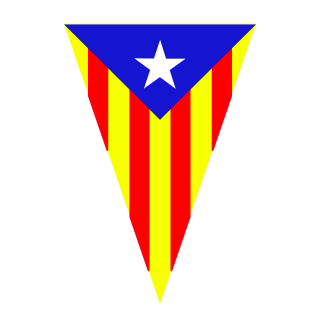
Lluís Companys i Jover was a Catalan politician who served as president of Catalonia from 1934 and during the Spanish Civil War.

Modernisme, also known as Catalan modernism and Catalan art nouveau, is the historiographic denomination given to an art and literature movement associated with the search of a new entitlement of Catalan culture, one of the most predominant cultures within Spain. Nowadays, it is considered a movement based on the cultural revindication of a Catalan identity. Its main form of expression was Modernista architecture, but it also encompassed many other arts, such as painting and sculpture, and especially the design and the decorative arts, which were particularly important, especially in their role as support to architecture. Modernisme was also a literary movement.
The Republican Left of Catalonia is a pro-Catalan independence, social democratic political party in the Spanish autonomous community of Catalonia, with a presence also in Valencia, the Balearic Islands and the French department of Pyrénées-Orientales. It is also the main sponsor of the independence movement from France and Spain in the territories known as Catalan Countries, focusing in recent years on the creation of a Catalan Republic in Catalonia proper. Its current president is Oriol Junqueras and its secretary-general is Marta Rovira. The party is a member of the European Free Alliance.

The Unified Socialist Party of Catalonia was a communist political party active in Catalonia between 1936 and 1997. It was the Catalan branch of the Communist Party of Spain and the only party not from a sovereign state to be a full member of the Third International.

The Palace of the Generalitat of Catalonia is a historic palace in Barcelona, Catalonia, Spain. It houses the offices of the Presidency of the Generalitat de Catalunya. It is one of the few buildings of medieval origin in Europe that still functions as a seat of government and houses the institution that originally built it.

Estat Català is a pro-independence nationalist historical political party of Catalonia (Spain).

Santa Maria de Montserrat is an abbey of the Order of Saint Benedict located on the mountain of Montserrat in Monistrol de Montserrat, Catalonia, Spain. It is notable for enshrining the image of the Virgin of Montserrat. The monastery was founded in 1025 and rebuilt between the 19th and 20th centuries. With a community of around 70 monks, the abbey is still in use to this day.

Institució de les Lletres Catalanes is a Spanish organization based in Barcelona. An entity of the Government of Catalonia, it was founded in 1937 by intellectuals who were loyal to the Republic during the Spanish Civil War. Its immediate predecessor was the Grup Sindical d'Escriptors Catalans. The institute was initially set up in four sections:
Left Nationalists was a Catalan socialist and independentist political organization founded in 1979 from historical militants of the Socialist Party of National Liberation (PSAN), National Front of Catalonia, Catalan Communist Collective and independents linked to social movements. Its structure was based in local assemblies, and claimed the right to self-determination of Catalonia within a confederal Catalan Countries. NE also defined itself as national-popular and socialist. The party attracted activist from social movements, specially environmentalists, feminists, gays, youth, etc. The most representative were Jordi Carbonell, Josep Maria Espinàs, Magda Oranich, Avel·lí Artís i Gener and Armand de Fluvià. NE disbanded in 1984.

Public art in Barcelona is a designated group of monuments and outdoor sculptures in the city. The artworks in city's architecture and network of museums, parks, and gardens, put an artistic stamp on the Catalan capital. Public art in the city developed in the 19th century, although the first municipal commission was the 1673 monument to Saint Eulalia in Pedró Square.

The 1934 Barcelona City Council election was held on Sunday, 14 January 1934, to elect the Barcelona City Council, the unicameral local legislature of the municipality of Barcelona, together with the other 1,029 Catalan municipalities. At stake were all 40 seats in the City Council, determining the Mayor of Barcelona. These were the first local elections where women were able to vote.

The Catalan Republic was a state proclaimed in 1931 by Francesc Macià as the "Catalan Republic within the Iberian Federation", in the context of the proclamation of the Second Spanish Republic. It was proclaimed on 14 April 1931, and superseded three days later, on 17 April, by the Generalitat de Catalunya, the Catalan institution of self-government within the Spanish Republic.

Joan Amigó i Barriga (1875–1958) was a Spanish architect, a late representative of the modernism and the most important of this style in Badalona.














